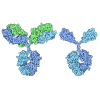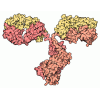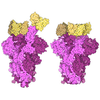+ データを開く
データを開く
- 基本情報
基本情報
| 登録情報 | データベース: PDB / ID: 9jec | ||||||||||||||||||||||||
|---|---|---|---|---|---|---|---|---|---|---|---|---|---|---|---|---|---|---|---|---|---|---|---|---|---|
| タイトル | Cryo-EM structure of canine TNF-alpha complexed with nanobody TNF30K | ||||||||||||||||||||||||
 要素 要素 |
| ||||||||||||||||||||||||
 キーワード キーワード | CYTOKINE / canine / TNF / nanobody / lymphokine | ||||||||||||||||||||||||
| 機能・相同性 |  機能・相同性情報 機能・相同性情報TNFR1-induced proapoptotic signaling / Regulation of TNFR1 signaling / TNFR1-induced NF-kappa-B signaling pathway / TNFR1-mediated ceramide production / TNFR2 non-canonical NF-kB pathway / TNF signaling / negative regulation of branching involved in lung morphogenesis / positive regulation of interleukin-33 production / positive regulation of blood microparticle formation / positive regulation of chronic inflammatory response to antigenic stimulus ...TNFR1-induced proapoptotic signaling / Regulation of TNFR1 signaling / TNFR1-induced NF-kappa-B signaling pathway / TNFR1-mediated ceramide production / TNFR2 non-canonical NF-kB pathway / TNF signaling / negative regulation of branching involved in lung morphogenesis / positive regulation of interleukin-33 production / positive regulation of blood microparticle formation / positive regulation of chronic inflammatory response to antigenic stimulus / positive regulation of protein transport / positive regulation of leukocyte adhesion to arterial endothelial cell / positive regulation of vitamin D biosynthetic process / positive regulation of translational initiation by iron / regulation of membrane lipid metabolic process / regulation of endothelial cell apoptotic process / chronic inflammatory response to antigenic stimulus / regulation of branching involved in salivary gland morphogenesis / negative regulation of protein-containing complex disassembly / positive regulation of humoral immune response mediated by circulating immunoglobulin / positive regulation of hair follicle development / negative regulation of vascular wound healing / negative regulation of cytokine production involved in immune response / negative regulation of amyloid-beta clearance / inflammatory response to wounding / death receptor agonist activity / epithelial cell proliferation involved in salivary gland morphogenesis / negative regulation of D-glucose import / embryonic digestive tract development / vascular endothelial growth factor production / positive regulation of fever generation / positive regulation of synoviocyte proliferation / necroptotic signaling pathway / positive regulation of calcineurin-NFAT signaling cascade / leukocyte tethering or rolling / negative regulation of myoblast differentiation / positive regulation of protein-containing complex disassembly / regulation of establishment of endothelial barrier / endothelial cell apoptotic process / positive regulation of protein localization to cell surface / macrophage activation involved in immune response / positive regulation of osteoclast differentiation / tumor necrosis factor receptor binding / positive regulation of heterotypic cell-cell adhesion / positive regulation of cytokine production involved in inflammatory response / positive regulation of macrophage derived foam cell differentiation / regulation of immunoglobulin production / negative regulation of mitotic cell cycle / positive regulation of podosome assembly / positive regulation of membrane protein ectodomain proteolysis / positive regulation of chemokine (C-X-C motif) ligand 2 production / positive regulation of extrinsic apoptotic signaling pathway / negative regulation of bicellular tight junction assembly / regulation of reactive oxygen species metabolic process / negative regulation of viral genome replication / positive regulation of amyloid-beta formation / regulation of synapse organization / negative regulation of endothelial cell proliferation / positive regulation of JUN kinase activity / positive regulation of MAP kinase activity / negative regulation of interleukin-6 production / humoral immune response / negative regulation of blood vessel endothelial cell migration / positive regulation of glial cell proliferation / extrinsic apoptotic signaling pathway via death domain receptors / negative regulation of extrinsic apoptotic signaling pathway in absence of ligand / negative regulation of osteoblast differentiation / positive regulation of synaptic transmission / negative regulation of lipid catabolic process / phagocytic cup / positive regulation of vascular associated smooth muscle cell proliferation / JNK cascade / extracellular matrix organization / antiviral innate immune response / regulation of insulin secretion / response to glucocorticoid / osteoclast differentiation / positive regulation of interleukin-1 beta production / cytokine activity / tumor necrosis factor-mediated signaling pathway / cellular response to ionizing radiation / positive regulation of interleukin-8 production / protein localization to plasma membrane / positive regulation of protein localization to plasma membrane / positive regulation of JNK cascade / cellular response to amino acid stimulus / phosphatidylinositol 3-kinase/protein kinase B signal transduction / microglial cell activation / positive regulation of non-canonical NF-kappaB signal transduction / positive regulation of NF-kappaB transcription factor activity / recycling endosome / cellular response to type II interferon / positive regulation of interleukin-6 production / cellular response to nicotine / positive regulation of miRNA transcription / positive regulation of type II interferon production / glucose metabolic process / positive regulation of protein phosphorylation / intrinsic apoptotic signaling pathway in response to DNA damage / positive regulation of nitric oxide biosynthetic process 類似検索 - 分子機能 | ||||||||||||||||||||||||
| 生物種 |   | ||||||||||||||||||||||||
| 手法 | 電子顕微鏡法 / 単粒子再構成法 / クライオ電子顕微鏡法 / 解像度: 3.1 Å | ||||||||||||||||||||||||
 データ登録者 データ登録者 | Weng, J. / Li, Z. / Xu, J. / Wei, Z. | ||||||||||||||||||||||||
| 資金援助 |  中国, 2件 中国, 2件
| ||||||||||||||||||||||||
 引用 引用 |  ジャーナル: To Be Published ジャーナル: To Be Publishedタイトル: Cryo-EM structure of canine TNF-alpha complexed with nanobody TNF30K 著者: Weng, J. / Li, Z. / Xu, J. / Wei, Z. | ||||||||||||||||||||||||
| 履歴 |
|
- 構造の表示
構造の表示
| 構造ビューア | 分子:  Molmil Molmil Jmol/JSmol Jmol/JSmol |
|---|
- ダウンロードとリンク
ダウンロードとリンク
- ダウンロード
ダウンロード
| PDBx/mmCIF形式 |  9jec.cif.gz 9jec.cif.gz | 193 KB | 表示 |  PDBx/mmCIF形式 PDBx/mmCIF形式 |
|---|---|---|---|---|
| PDB形式 |  pdb9jec.ent.gz pdb9jec.ent.gz | 123.8 KB | 表示 |  PDB形式 PDB形式 |
| PDBx/mmJSON形式 |  9jec.json.gz 9jec.json.gz | ツリー表示 |  PDBx/mmJSON形式 PDBx/mmJSON形式 | |
| その他 |  その他のダウンロード その他のダウンロード |
-検証レポート
| 文書・要旨 |  9jec_validation.pdf.gz 9jec_validation.pdf.gz | 1.1 MB | 表示 |  wwPDB検証レポート wwPDB検証レポート |
|---|---|---|---|---|
| 文書・詳細版 |  9jec_full_validation.pdf.gz 9jec_full_validation.pdf.gz | 1.2 MB | 表示 | |
| XML形式データ |  9jec_validation.xml.gz 9jec_validation.xml.gz | 32.3 KB | 表示 | |
| CIF形式データ |  9jec_validation.cif.gz 9jec_validation.cif.gz | 49.1 KB | 表示 | |
| アーカイブディレクトリ |  https://data.pdbj.org/pub/pdb/validation_reports/je/9jec https://data.pdbj.org/pub/pdb/validation_reports/je/9jec ftp://data.pdbj.org/pub/pdb/validation_reports/je/9jec ftp://data.pdbj.org/pub/pdb/validation_reports/je/9jec | HTTPS FTP |
-関連構造データ
| 関連構造データ |  61412MC M: このデータのモデリングに利用したマップデータ C: 同じ文献を引用 ( |
|---|---|
| 類似構造データ | 類似検索 - 機能・相同性  F&H 検索 F&H 検索 |
- リンク
リンク
- 集合体
集合体
| 登録構造単位 | 
|
|---|---|
| 1 |
|
- 要素
要素
| #1: タンパク質 | 分子量: 19123.730 Da / 分子数: 3 / 由来タイプ: 組換発現 / 由来: (組換発現)   #2: 抗体 | 分子量: 14463.364 Da / 分子数: 3 / 由来タイプ: 組換発現 / 由来: (組換発現)   Has protein modification | Y | |
|---|
-実験情報
-実験
| 実験 | 手法: 電子顕微鏡法 |
|---|---|
| EM実験 | 試料の集合状態: PARTICLE / 3次元再構成法: 単粒子再構成法 |
- 試料調製
試料調製
| 構成要素 | 名称: Hexamer complex of canine TNF-alpha and nanobody TNF30K タイプ: COMPLEX 詳細: a hexamer complex consist of one canine TNF-alpha trimer with three nanobody TNF30K molecules Entity ID: all / 由来: RECOMBINANT | |||||||||||||||||||||||||
|---|---|---|---|---|---|---|---|---|---|---|---|---|---|---|---|---|---|---|---|---|---|---|---|---|---|---|
| 分子量 | 値: 1.01 MDa / 実験値: NO | |||||||||||||||||||||||||
| 由来(天然) | 生物種:  | |||||||||||||||||||||||||
| 由来(組換発現) | 生物種:  | |||||||||||||||||||||||||
| 緩衝液 | pH: 7.4 詳細: 10 mM Na2HPO4, 1.8 mM KH2PO4, 137 mM NaCl, 2.7 mM KCl, pH 7.4 | |||||||||||||||||||||||||
| 緩衝液成分 |
| |||||||||||||||||||||||||
| 試料 | 濃度: 1.1 mg/ml / 包埋: NO / シャドウイング: NO / 染色: NO / 凍結: YES / 詳細: This sample was FPLC purified and monodisperse. | |||||||||||||||||||||||||
| 試料支持 | グリッドの材料: COPPER / グリッドのサイズ: 300 divisions/in. / グリッドのタイプ: Quantifoil R1.2/1.3 | |||||||||||||||||||||||||
| 急速凍結 | 装置: FEI VITROBOT MARK IV / 凍結剤: ETHANE / 湿度: 100 % / 凍結前の試料温度: 277 K |
- 電子顕微鏡撮影
電子顕微鏡撮影
| 実験機器 |  モデル: Titan Krios / 画像提供: FEI Company |
|---|---|
| 顕微鏡 | モデル: FEI TITAN KRIOS |
| 電子銃 | 電子線源:  FIELD EMISSION GUN / 加速電圧: 300 kV / 照射モード: FLOOD BEAM FIELD EMISSION GUN / 加速電圧: 300 kV / 照射モード: FLOOD BEAM |
| 電子レンズ | モード: BRIGHT FIELD / 最大 デフォーカス(公称値): 2000 nm / 最小 デフォーカス(公称値): 1000 nm / Cs: 2.7 mm |
| 試料ホルダ | 凍結剤: NITROGEN |
| 撮影 | 平均露光時間: 2.5 sec. / 電子線照射量: 54 e/Å2 / フィルム・検出器のモデル: GATAN K3 (6k x 4k) |
- 解析
解析
| CTF補正 | タイプ: PHASE FLIPPING AND AMPLITUDE CORRECTION | ||||||||||||||||||||||||
|---|---|---|---|---|---|---|---|---|---|---|---|---|---|---|---|---|---|---|---|---|---|---|---|---|---|
| 3次元再構成 | 解像度: 3.1 Å / 解像度の算出法: FSC 0.143 CUT-OFF / 粒子像の数: 543326 / 対称性のタイプ: POINT | ||||||||||||||||||||||||
| 原子モデル構築 | 空間: REAL | ||||||||||||||||||||||||
| 精密化 | 交差検証法: NONE 立体化学のターゲット値: GeoStd + Monomer Library + CDL v1.2 | ||||||||||||||||||||||||
| 原子変位パラメータ | Biso mean: 104.38 Å2 | ||||||||||||||||||||||||
| 拘束条件 |
|
 ムービー
ムービー コントローラー
コントローラー



 PDBj
PDBj


